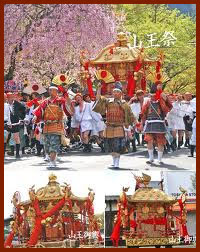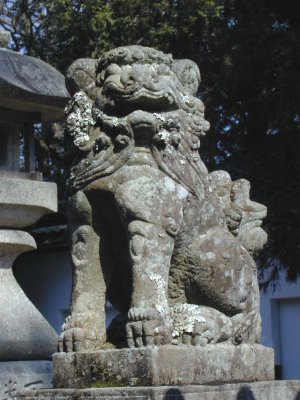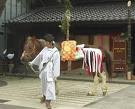:::::::::::::::::::::::::::::::::::::::::::::::::::::::::::::::::::::::::::::::::::::::::::::::::::
Hiyoshi Shrine Festivals
***** Location: Otsu
***** Season: Various, see below
***** Category: Observance
*****************************
Explanation

Hiyoshi Shrine (日吉大社 Hiyoshi taisha),
also known as Hiyoshi jinja (日吉神社) or Hie jinja,
is a Shinto shrine located at 大津 Ōtsu in Shiga Prefecture, Japan.
The shrine became the object of Imperial patronage during the early Heian period. In 965, Emperor Murakami ordered that Imperial messengers were sent to report important events to the guardian kami of Japan. These heihaku were initially presented to 16 shrines; and in 991, Emperor Ichijō added three more shrines to Murakami's list. Three years later in 994, Ichijō refined the scope of that composite list by adding Umenomiya Shrine and Gion Shrine, which is now known as Yasaka Jinja.
In 1039, Emperor Go-Suzaku ordered that one more shrine be added to the grouping created by Murakami and Ichijō -- the Hie jinja. This unique number of Imperial-designated shrines has not been altered since that time.
© More in the WIKIPEDIA !
Sanno, the "Mountain King"
A branch of Shinto that took shape in the Tendai sect, based on the cult of the Mountain King (Sannō) at the Hiyoshi Taisha (alt., Hie Taisha), tutelary shrine (chinjusha) for the temple Enryakuji. Its early modern doctrines that concern the shrine Tōshōgū are specially distinguished as Ichijitsu Shintō, the "Shinto of the Single Reality." The original Hie deity was the mountain kami on Mt. Hiei; interaction between it and the Tendai sect began with Saichō's founding of the Enryakuji.
The appellation "Mountain King" follows a general Buddhist practice of designating mountain deities as such ...
source : Sato Masato, Kokugakuin
:::::::::::::::::::::::::::::::::::::::::::::::::::::::::::::::::::::::::::::::::::::::::::::::::::

kigo for late spring
Sannoo matsuri 山王祭 (さんのうまつり) Sanno Festival
Sanno sai, San-O Festival
Hiyoshi matsuri 日吉祭(ひよしまつり) Hiyoshi festival
sakaki giri 榊伐(さかきぎり)cutting sakaki branches
sarumatsuri 申祭(さるまつり)monkey festival
saru no jinku 猿の神供(さるのじんく)ritual for the monkey
uma no shinji 午の神事(うまのしんじ) ritual for the horse
hitsuji no goku 未の御供(ひつじのごく)ritual for the sheep
April 14
At the Grand Hie (Hiyoshi) Shrine at Otsu
滋賀県大津市坂本町の日吉神社
It used to be on the middle day of the monkey (naka no saru 中の申) of the Asian lunar calendar, therefore it is also called "Monkey Festival".
It dates back to 1303.
The cutting of sacred sakaki branches happens on April 3.
On the "day of the horse" the mikoshi were carried to the mountain top at midnight.
An the 12th the mikoshi are pulled out in a nightly procession illuminated with large pine torches and on the main day 7 large mikoshi parade the streets.
. WKD : Sakaki tree (sakaki 榊) .
.................................................................................
There are three major festivals in Otsu:
Sanno Festival - April 12-15
Senko Festival - August 16
Otsu Festival - October 9-10
:::::::::::::::::::::::::::::::::::::::::::::::::::::::::::::::::::::::::::::::::::::::::::::::::::

. Hie Shrine Festival (Hie Jinja Sairei 日枝神社祭礼)
Sannoo matsuri 山王祭(さんのうまつり)Sanno festival
In Edo/Tokyo
kigo for mid-summer
The Hie Jinja Shrine (Tokyo) is dedicated to Sanno Gongen (山王権現), which translates literally as "Mountain King Avatar" of Sannoo, the deity who dwells on Mt. Hiei between Kyoto and Lake Biwa.
SANNO GONGEN 山王権現
SARUGAMI 猿神
Monkeys are patrons of harmonious marriage and safe childbirth at some of the 3,800 Hie Jinja shrines in Japan. ... The monkey is Sannou's Shinto messenger (tsukai 使い) and Buddhist avatar (gongen 権現).
Sarugami is the Shinto deity to whom the three monkeys (hear, speak, see no evil) are reportedly faithful.
source : Mark Schumacher
:::::::::::::::::::::::::::::::::::::::::::::::::::::::::::::::::::::::::::::::::::::::::::::::::::
quote
Hiyoshi Taisha Shrine [山王総本宮日吉大社]
Hiyoshi Taisha Shrine is the head shrine of approximately 3,800 Hiyoshi, Hie and Sanno shrines throughout Japan.
The history of Hiyoshi Taisha is long. It is recorded in "Kojiki," the oldest historiography in Japan written in 712. Its vast premises (about 430,000 m2) of this shrine are laid at the foot of Mt. Hachioji, east side of Mt. Hiei.
The shrine is comprised of two zones, Higashi Hongu (West main shrine) and Nishi Hongu (East main shrine), with many smaller shrines in the area.
In the Muromachi Period, the heyday of Hiyoshi Taisha Shrine, 108 shrines were located on its grounds and another 108 shrines outside the shrine premises.
Among many shrine buildings, main halls of Higashi Hongu (West main shrine) and Nishi Hongu (East main shrine) are designated as national treasures. Also, many structures of this shrine are recognized as important cultural assets of Japan including worship halls of the both Higashi Hongu and Nishi Hongu, Nishi Hongu Ro-mon Gate, the red two-storied gate with the carving of a monkey, and Sanno-torii Gate.
Spectacular shrine pavilions of architectural beauty, which were built in the Muromachi Period and the beginning of Edo Period, are scattered in the deep forest Mt. Hachioji and along the torrents of the Omiya River. The beauty of the autumn leaves in Hiyoshi Taisha Shrine is renowned. The premises are illuminated at night during the autumn season. In springtime many kinds of cherry blossoms fill the prefectural road from Keihan Railway Sakamoto Station to the entrance of Hiyoshi Taisha Shrine.
Also, Sanno Festival, the festival of Hiyoshi Taisha Shrine, is held in spring every year.
source : www.japan-i.jp
- quote
かつては境内108社・境外108社と言われていた。
以下に示す21社は主なものであり、山王二十一社と総称される
(Now there are 21 shrines in the compound
- one of them is dedicated to Fudo Myo-O
摂社
- shrine name - 早尾神社 Hayao Jinja
- Deity in residence - 素盞嗚神 - Susanoo no Mikoto
Old naming 早尾 -- 不動明王
- source : ja.wikipedia.org

This is a namikiri Fudo 波切不動明王.
- no photo fount yet -
There is also a
Yamakami Fudo Son 山上不動尊
in the compound, where a large sugi cedar with a shimenawa is celebrated.

Every month on the 28 fire rituals for Fudo Myo-O are held.
滋賀県大津市山上町
source : tanuki838.web.fc2.com/Taki
. Fudō Myō-ō, Fudoo Myoo-Oo 不動明王 Fudo Myo-O
Acala Vidyârâja - Vidyaraja - Fudo Myoo .
:::::::::::::::::::::::::::::::::::::::::::::::::::::::::::::::::::::::::::::::::::::::::::::::::::
quote
Sannō Shinkō - Sanno Shinko
The cult that began at Hiyoshi Taisha (Hiesha) at the foot of Mount Hiei. Originally, Sannō was the "mountain kami" (yama no kami) of Mount Hiei, but came to be worshipped as the protective kami of the Tendai (Chi. T'ient'ai) sect and of the temple Enryakuji. After the mid-Heian Period, when the temple Enryakuji developed as a kenmon (central land-owning institution) temple complex, imperial court devotion to Hiesha increased.
Courts such as that of Enyū emperor (reigned 969 ~ 984) conducted occasional festivals there and finally recognized Hieisha as one of the "Twenty-two Shrines" (nijūnisha). Moreover, from the end of the Heian Period through the medieval period, Hieisha became as popular as "Kumano's Three Peaks" (Kumano sanzan) as a pilgrimage site (sankei) among everyone from emperors and retired emperors to aristocrats and commoners.
At the beginning of the medieval period, along with the popularity of belief in "child deities" (dōji) and "offspring shrines" (wakamiya), the popularity of Jūzenji shrine (currently called Jugegū – one of Sannō's seven main shrines) surpassed that of Hieisha's Ōmiya shrine in which Hiesha's principle "enshrined kami" (saijin) is worshipped.
As the protective deity of Tendai temples and of Enryakuji or Hiesha's land holdings, Sannō "emanations" became worshipped (bunshi) throughout Japan resulting in the further spread of the cult of Sannō.
Because Hiesha is located to the northeast of Kyōto, it became regarded as a guardian against the evil spirits entering the capital from "demon gate" (kimono) northeastern direction, and as a result sacred images (shinzō) of divine monkeys believed to be Sannō's "divine messengers" (shinshi) were enshrined in the northeastern corner of the Heian imperial palace.
source : Sato Masato
Kokugakuin University 2007
:::::::::::::::::::::::::::::::::::::::::::::::::::::::::::::::::::::::::::::::::::::::::::::::::::
quote
Numazu Hie-jinja 沼津 日枝神社 Hie Shrine in Numazu
Hie Shrine in Numazu City, Shizuoka Prefecture, had been the head guardian shrine of 22 villages in the area before the Meiji period (1868-1912). The enshrined deities are Ooyamakui no Kami The guardian god of Mt. Hiei), Oomunachi no Kami and Ootoshigami. It is said that the shrine was founded by Fujiwara no Moromichi’s mother in 1100 in the clan’s manor, which was called “Ooka-sho” at that time.
Fujiwara no Moromichi was a head of the Fujiwara clan and served as Kampaku and Udaijin. Having come into colligion with the Tendai monks in Mt. Hiei, he ordered to attack them in 1095. As some monks were wounded in the battle and this aroused anger of the monks, he was placed a curse and died young in 1099. Thus his mother transferred the three dieties of Hiyoshi Taisha Shrine in Mt. Hiei to appease the anger of the deities of Mt. Hiei.
Traditionally, the school of Shinto which believes in the guardian deity of Mt. Hiei is called the Sanno (the King of Mountain) Shinto; hereby this shrine is also called “Sanno-sha”. The annual festival held for two days from September 23 every year is popularly called “Sanno-san” by the local people and enjoyed as the representative event of the city that tells of the coming of autumn.
The shrine is also famous for the collection of important old documents including Sanno Reikenki in Shihon-Chakushoku style (paper-based colored), which is a nationally designated Important Cultural Property.
In the precinct is a stone monument inscribed with a poem by Matsuo Basho.
source : nippon-kichi.jp

都出て神も旅寝の日数哉
miyako idete kami mo tabine no hikazu kana
I left the capital
and shared many nights on the road
with the gods
Matsuo Basho, 1691
Basho had left Kyoto late in the 10th lunar month and arrived in Numazu on his way to Edo early in the 11th lunar month, just when the gods are absentin Izumo and might have been on their way home too.
. WKD : Gods are absent (kami no rusu) .
. Numazu-juku 沼津宿 Numazu postal station .
MORE - hokku about Kyoto
. Matsuo Basho 松尾芭蕉 - Archives of the WKD .
*****************************
Worldwide use
*****************************
Things found on the way
. Sumiyoshi Grand Shrine
(住吉大社, Sumiyoshi-taisha)
The shrine became the object of Imperial patronage during the early Heian period. In 965, Emperor Murakami ordered that Imperial messengers were sent to report important events to the guardian kami of Japan. These heihaku were initially presented to 16 shrines including the Sumiyoshi Shrine.
:::::::::::::::::::::::::::::::::::::::::::::::::::::::::::::::::::::::::::::::::::::::::::::::::::::
Monkey Amulet from Hiyoshi Shrine

Click for more images!
saru monkey - a pun on the sound of SARU
ma ga saru 魔が去る evil is leaving
ma saru 魔去る evil is leaving
masaru 勝る winning
神猿 Masaru

.................................................................................

O-Saru Sama お猿様 Honoarble Mister Monkey
Monkey amulets from shrine Hagi Hiyoshi Jinja in Saitama.
萩日吉神社
They are simple wooden dolls with simple monkey faces.
The wood is taken from the trees in the temple ground, a kind of willow, doro no ki 泥の木/白楊 (doro yanagi).
People used to stick one needle into the monkey, at the part they were acheing themselves, or when the children got a stomach ache or other complaint, and hoped for the deity to cure their disease. (byooki sa saru - may the disease go away). They put the monkey on their shelf for the gods and prayed to it.
The monkey would then take on the disease and heal it, as a kind of migawari, personal substitute .
When the person gets better people would bring the monkey back in an act of gratitude (osame no saru 納めの猿).
They are sold on the special market during the festival on the third sunday in January.
At this shrine, there is also a yabusame festival, shooting arrows from horseback, once in three years.
. Saru 申 / 猿 Monkey Amulets .
. Migawari - personal substitute amulets .
*****************************
HAIKU
*****************************
Related words
***** . Gion Festival (Gion matsuri 祇園祭り)
***** . Shrine Karasaki Jinja 唐崎神社 .
and the Hiyoshi shrine in Otsu
BACK : Top of this Saijiki
[ . BACK to WORLDKIGO . TOP . ]
:::::::::::::::::::::::::::::::::::::::::::::::::::::::::::::::::::::::::::::::::::::::::::::::::::::













































